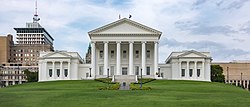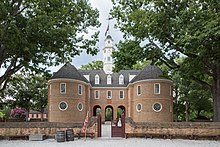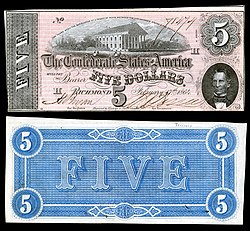Virginia State Capitol
Virginia State Capitol | |
 The Virginia State Capitol Building in Richmond in August 2017 | |
 | |
| Location | 1000 Bank St, Richmond, Virginia, U.S. |
|---|---|
| Built | 1785–1788 |
| Architect | Thomas Jefferson; Charles-Louis Clérisseau |
| Architectural style | Early Republic, Palladian |
| NRHP reference No. | 66000911[1] |
| VLR No. | 127-0002 |
| Significant dates | |
| Added to NRHP | October 15, 1966 |
| Designated NHL | December 19, 1960[3] |
| Designated VLR | November 5, 1968[2] |
The Virginia State Capitol is the seat of state government of the Commonwealth of Virginia, located in Richmond, the state capital. It houses the oldest elected legislative body in North America, the Virginia General Assembly, first established as the House of Burgesses in 1619.
The Capitol was conceived of by
History
Colonial precursors in Jamestown and Williamsburg


During the
With the decision to relocate the government inland to Williamsburg in 1699, a grand new Capitol building was completed in November 1705. Nearby was the grand Governor's Palace. It burned in 1747 and was replaced in 1753. On June 29, 1776, Virginians declared their independence from Great Britain and wrote the state's first constitution, thereby creating an independent government four days before Congress voted for the Declaration of Independence in Philadelphia on July 4.
The Capitol at Williamsburg served until the American Revolutionary War began, when Governor Thomas Jefferson urged that the capital be relocated to Richmond. The building was last used as a capitol on December 24, 1779, when the Virginia General Assembly adjourned to reconvene in 1780 at the new capital, Richmond. It was eventually destroyed.
Richmond and state capitol design

When it convened in Richmond on May 1, 1780, the legislature met in a makeshift building near Shockoe Bottom. By 1788, the "Old Capitol" where the Virginia Ratifying Convention met was at the New Academy by the Chevalier Quesnay.
Plans were begun for a new building to serve a new state, the
The cornerstone was laid on August 18, 1785, with Governor Patrick Henry in attendance, prior to the completion of its design. In 1786, a set of architectural drawings and a plaster model were sent from France to Virginia, where it was executed by Samuel Dobie. It was sufficiently completed for the General Assembly to meet there in October 1792.
It is one of only twelve Capitols in the
American Civil War
The building also served as the Capitol of the Confederacy during the American Civil War (1861–65) (It was the Confederacy's second home, the first being the Alabama State Capitol in Montgomery, Alabama).
The Capitol, the adjacent
The first
From April 6 until April 10, 1865 Lynchburg served as the Capital of Virginia. Under Gov. William Smith, the executive and legislative branches of the commonwealth moved to Lynchburg for the few days between the fall of Richmond and the fall of the Confederacy.
On July 24, 2020, House Speaker
1870 Tragedy

After the end of the
The injured stumbled, crawled or were carried out onto the Capitol lawn during the mayhem that followed. Sixty-two people were killed and 251 injured.
Rebuilding, expansion, renovation

Despite demands for the building's demolition, the damage from the tragedy of 1870 was repaired. In 1904, two wings (not in the original plans) were added to the east and west ends of the building to provide much-needed additional space for the growing legislature. These additions were built to the collaborative designs of three of Virginia's leading architects and architectural firms:
In 2003, the assembly approved $83.1 million for the renovation, restoration and expansion of the Capitol. Work began in 2004 and was completed on May 1, 2007. Among major changes are a completely new
The
Individuals known to have lain in state/repose
- June 1806: George Wythe, Signer of the Declaration of Independence from Virginia
- January 21, 1862: John Tyler, Tenth President of the United States; 23rd Governor of Virginia
- May 15, 1863: Thomas J. "Stonewall" Jackson, Confederate general
- June 15, 1971: J. Sargeant Reynolds, then-Lieutenant Governor of Virginia
- September 30, 1991: A. L. Philpott, then-Speaker of the Virginia House of Delegates
- February 11, 2011: Leroy R. Hassell Sr., then-Chief Justice of the Virginia Supreme Court (first African American in Virginia to be afforded the honor)
- January 29–30, 2013 Harry L. Carrico, Former Chief Justice with over 42 years of service as an active Justice on the Virginia Supreme Court
- September 6, 2017: Lacey Putney, Former House Speaker and longest serving legislator in Virginian history (1962–2014)
Interior
-
Rotunda, withstatue of George Washingtonin the center
-
Roof of the rotunda
-
Old House of Delegates Chamber
-
(New) House of Delegates Chamber
-
Senate Chamber (in session)
Capitol Square
Bell Tower | |
| Location | Capitol Sq., Richmond, Virginia |
|---|---|
| Area | 14.1 acres (5.7 ha) |
| Built | 1824 |
| Architect | Swain, Levi |
| Architectural style | Federal |
| NRHP reference No. | 69000347[1] |
| VLR No. | 127-0121 |
| Significant dates | |
| Added to NRHP | June 11, 1969 |
| Designated VLR | November 5, 1968[2] |
The area around the Capitol is known as Capitol Square. It contains several monuments to prominent Virginians and events in Virginia:
- Washington Monument, 1858
- In 1869, the monument was completed, with statues of the following encircling the base:
- General Thomas J. "Stonewall" JacksonStatue, 1875
- Governor William "Extra Billy" Smith Statue, 1906
- Dr. Hunter Holmes McGuire Statue, 1904
- Zero Milestone, 1929, for measuring highway distances from the city of Richmond
- Edgar Allan Poe Statue, 1958
- Harry F. Byrd Sr. Statue, 1976
- Virginia Civil Rights Memorial, 2008
- The Bell Tower was built in 1824–1825. It is still used for ceremonial ringing.
- Oliver Hill Building(1892-1894)
In film and television
Given its
In the 1993 comedy-drama film Dave with Kevin Kline, Sigourney Weaver, Frank Langella; the House of Delegates chamber served as the set for the United States House of Representatives, where the title character President addresses a joint session of Congress.
In the 2012 film Lincoln, the Virginia State Capitol was used as a stand-in for the United States Capitol in Washington D.C. during the Civil War era with some film retouching.
See also
- List of National Historic Landmarks in Virginia
- National Register of Historic Places listings in Richmond, Virginia
- List of state and territorial capitols in the United States
References
- ^ a b "National Register Information System". National Register of Historic Places. National Park Service. March 15, 2006.
- ^ a b "Virginia Landmarks Register". Virginia Department of Historic Resources. Archived from the original on 21 September 2013. Retrieved 19 March 2013.
- ^ "Confederate Capitol". National Historic Landmark summary listing. National Park Service. Archived from the original on December 27, 2007. Retrieved June 23, 2008.
- ^ "Jamestown Churches". National Park Service. Retrieved February 2, 2014.
- Richmond Theater
- ISBN 0-06-430158-3.
- ^ Brownell, Charles E. (1992). The Making of Virginia Architecture. Virginia Museum of Fine Arts. pp. 46–53, 214–217.
- ^ "Domes, Domes, Domes". National Conference of State Legislators. January 21, 2020. Retrieved March 22, 2020.
- newspapers.com.
- ^ Schneider, Gregory S. (July 24, 2020). "Confederate memorials quietly removed from Virginia Capitol overnight". Washington Post. Retrieved December 22, 2020.
- ^ "Virginia evicts Confederate monuments from its state Capitol". AP NEWS. July 24, 2020. Retrieved December 22, 2020.
- ^ Christian, George L. (1915). The Capitol disaster. A chapter of reconstruction in Virginia. Richmond, Virginia: Richmond Press, Inc.
- ^ Engineering News 9 June 1904: 447. New York.
- ^ ArchSTUDIO2227: The Virginia Capitol Extension
- ^ "U.S. capitals on edge for armed protests as Trump presidency nears end". Yahoo. January 16, 2021. Retrieved January 16, 2021.
- ^ ""The Contender" – filmed on location in Virginia and starring Gary Oldman, Joan Allen and Jeff Bridges – opens October 13" (PDF) (Press release). Virginia Film Office. September 28, 2000. Retrieved January 30, 2013.
External links
- Official website
- Visiting Information from the Virginia General Assembly Archived May 11, 2008, at the Wayback Machine
- State Library of Virginia – Virginia State Capitol online exhibit Archived 2005-03-21 at the Wayback Machine
- "A Brief History of the Public Privy on Capitol Square" at Virginia Memory
- Virginia State Capitol, Bank and 10th Streets, Capitol Square, Richmond, Independent City, VA: 155 photos, 12 color transparencies, 48 measured drawings, 88 data pages, and 12 photo caption pages at Historic American Buildings Survey
- The Bell Tower, Capitol Square, Richmond, Independent City, VA: 2 photos, 2 measured drawings, and 6 data pages at Historic American Buildings Survey








